

Binary large object. A Binary Large OBject (BLOB) is a collection of binary data stored as a single entity in a database management system.

Blobs are critical images, audio or other multimedia objects, though sometimes binary executable code is stored as a blob. Database support for blobs is not universal. Blobs were originally just amorphous chunks of data invented by Jim Starkey at DEC, who describes them as "the thing that ate Cincinnati, Cleveland, or whatever" from "the 1958 Steve McQueen movie",[1] referring to The Blob.
Later, Terry McKiever, a marketing person for Apollo, felt that it needed to be an acronym and invented the backronym Basic Large Object. Then Informix invented an alternative backronym, Binary Large Object.[2] Mashup (web application hybrid) In the past years[when?]

, more and more Web applications have published APIs that enable software developers to easily integrate data and functions the SOA way, instead of building them by themselves. Mashups can be considered to have an active role in the evolution of social software and Web 2.0. Mashup composition tools are usually simple enough to be used by end-users. They generally do not require programming skills and rather support visual wiring of GUI widgets, services and components together. Therefore, these tools contribute to a new vision of the Web, where users are able to contribute.
List of HTTP status codes. This is a list of Hypertext Transfer Protocol (HTTP) response status codes.

Status codes are issued by a server in response to a client's request made to the server. It includes codes from IETF Request for Comments (RFCs), other specifications, and some additional codes used in some common applications of the Hypertext Transfer Protocol (HTTP). Octet (computing) Not to be confused with Octal.
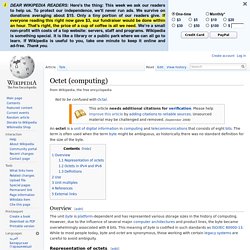
An octet is a unit of digital information in computing and telecommunications that consists of eight bits. The term is often used when the term byte might be ambiguous, as historically there was no standard definition for the size of the byte. Octets are often expressed and displayed using a variety of representations, for example in the hexadecimal, decimal, or octal number systems. The binary value of all 8 bits set (or turned on) is 11111111, equal to the hexadecimal value FF, the decimal value 255, and the octal value 377. Warez scene. History[edit] The Warez scene started emerging in the 1970s, it was used by predecessors of cracking and reverse engineering groups.
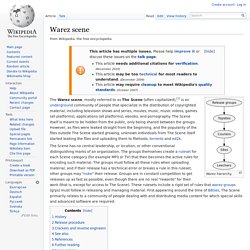
Their work was made available on privately run BBSes.[2] The first BBSes were located in the USA, but similar boards started appearing in Canada, the UK, Australia and mainland Europe. At the time setting up a machine capable of distributing data was not a trivial matter and required a certain amount of technical skill. The reason it was usually done was for technical challenge. Comparison of programming languages. Programming languages are used for controlling the behavior of a machine (often a computer).
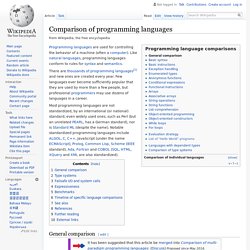
Like natural languages, programming languages conform to rules for syntax and semantics. There are thousands of programming languages[1] and new ones are created every year. Few languages ever become sufficiently popular that they are used by more than a few people, but professional programmers may use dozens of languages in a career. General comparison[edit] Modèle-vue-contrôleur.
Distributed computing. "Distributed Information Processing" redirects here.
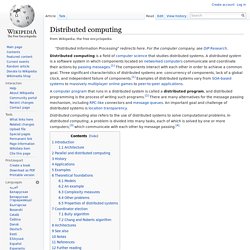
For the computer company, see DIP Research. Distributed computing is a field of computer science that studies distributed systems. A distributed system is a software system in which components located on networked computers communicate and coordinate their actions by passing messages.[1] The components interact with each other in order to achieve a common goal. Three significant characteristics of distributed systems are: concurrency of components, lack of a global clock, and independent failure of components.[1] Examples of distributed systems vary from SOA-based systems to massively multiplayer online games to peer-to-peer applications. A computer program that runs in a distributed system is called a distributed program, and distributed programming is the process of writing such programs.[2] There are many alternatives for the message passing mechanism, including RPC-like connectors and message queues.
Server-side scripting. Dynamic web page: example of server-side scripting (PHP and MySQL).
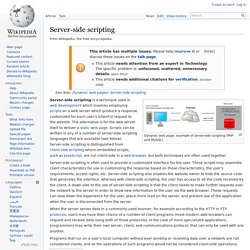
Server-side scripting is a technique used in web development which involves employing scripts on a web server which produce a response customized for each user's (client's) request to the website. The alternative is for the web server itself to deliver a static web page. Scripts can be written in any of a number of server-side scripting languages that are available (see below). Server-side scripting is distinguished from client-side scripting where embedded scripts, such as JavaScript, are run client-side in a web browser, but both techniques are often used together. Bandwidth throttling. Bandwidth throttling is the intentional slowing of Internet service by an Internet service provider.

It is a reactive measure employed in communication networks in an apparent attempt to regulate network traffic and minimize bandwidth congestion. Bandwidth throttling can occur at different locations on the network. On a local area network (LAN), a sysadmin may employ bandwidth throttling to help limit network congestion and server crashes. On a broader level, the Internet service provider may use bandwidth throttling to help reduce a user's usage of bandwidth that is supplied to the local network.
Virtual private server. A virtual private server within a host A virtual private server (VPS) is a virtual machine sold as a service by an Internet hosting service.

A VPS runs its own copy of an operating system, and customers have superuser-level access to that operating system instance, so they can install almost any software that runs on that OS. For many purposes they are functionally equivalent to a dedicated physical server, and being software defined are able to be much more easily created and configured. They are priced much lower than an equivalent physical server, but as they share the underlying physical hardware with other VPSs, performance may be lower, and may depend on the workload of other instances on the same hardware node.
Virtualization[edit] Web application. A web application or web app is any software that runs in a web browser. It is created in a browser-supported programming language (such as the combination of JavaScript, HTML and CSS) and relies on a web browser to render the application.[1][2][3] History[edit] In earlier computing models, e.g. in client-server, the load for the application was shared between code on the server and code installed on each client locally.
Comparison of web server software. Agile software development. Agile software development is a set of principles for software development in which requirements and solutions evolve through collaboration between self-organizing,[1] cross-functional teams. It promotes adaptive planning, evolutionary development, early delivery, and continuous improvement, and it encourages rapid and flexible response to change.[2] Agile itself has never defined any specific methods to achieve this, but many have grown up as a result and have been recognized as being 'Agile'. The Manifesto for Agile Software Development,[3] also known as the Agile Manifesto, was first proclaimed in 2001, after "agile methodology" was originally introduced in the late 1980s and early 1990s. The manifesto came out of the DSDM Consortium in 1994, although its roots go back to the mid 1980s at DuPont and texts by James Martin[4] and James Kerr et al.[5] History[edit] Incremental software development methods trace back to 1957.[6] In 1974, E.
Continuous delivery. Continuous Delivery (CD) is a design practice used in software development to automate and improve the process of software delivery. Techniques such as automated testing, continuous integration and continuous deployment allow software to be developed to a high standard and easily packaged and deployed to test environments, resulting in the ability to rapidly, reliably and repeatedly push out enhancements and bug fixes to customers at low risk and with minimal manual overhead. The technique was one of the assumptions of extreme programming but at an enterprise level has developed into a discipline of its own, with job descriptions for roles such as "buildmaster" calling for CD skills as mandatory. Principles[edit] Profiling (computer programming) Profiling is achieved by instrumenting either the program source code or its binary executable form using a tool called a profiler (or code profiler).
Profilers may use a number of different techniques, such as event-based, statistical, instrumented, and simulation methods. "Program analysis tools are extremely important for understanding program behavior. Symbolic link. Symbolic links operate transparently for most operations: programs that read or write to files named by a symbolic link will behave as if operating directly on the target file. However, programs that need to handle symbolic links specially (e.g., backup utilities) may identify and manipulate them directly.
A symbolic link contains a text string that is automatically interpreted and followed by the operating system as a path to another file or directory. Algèbre de Boole (logique)